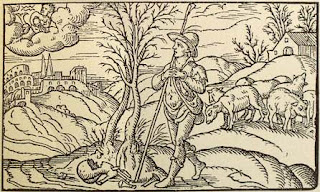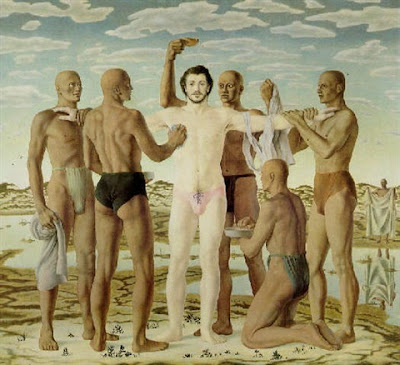The Black Image: The Harlem Renaissance.
In Ten 8 (1992) Kobena Mercer and Isaac Julien sketched out a discourse on black male sexuality. Their argument was based on a landscape of stereotypical desire that was ploughed according to the demands of white males. A fuller working of this thesis took place in Welcome to the Jungle with the co-authors following Foucault and Fanon to implicate the black male gaze within the area of prejudice, that is to say: racist imagery operates around a belief that black men are “hypersexual” and this is one of a number of myths (entrenched by historical slavery) that black males would rather not lose…have demystified. As bell hooks has asserted, this racist iconography is a source of power and men who are made powerless by society cling to power (however dubious it might be) because it affords an area in which they might exist. Mercer and Julien insist upon demystifying, however, and do so to provide a classic critique of Mapplethorpe and his art of sexual objectification. For Julien, this was artistically articulated in Looking for Langston (1989). Mercer, however, adopted a revised position in 1986 and 1989. His second essay, "How Do I Iook?" plays with a semantic ambiguity. The question could belong to the person viewed: how do I look to you? Or it could belong to the person viewing: how do I look at you? This double strand allowed Mercer to see Mapplethorpe in a gentler (less racist light)…would have to disagree here…for every photograph now speaks in two ways. It becomes the creation of the white man’s gaze and also an expression of black male desire (when viewed by a black male). Historically, Mercer’s re-looking at racial fetishism was justified: you only have to compare poets such as Branner and Harris to see a divergence in response:
thank you
mister Mapplethorpe
for lassoing all a’ my
crazy gazelle selves
and tying them
to 8 x 10 glossies
(“Poem for Robert”, DB Branner)
THAT’S RIGHT
COME SEE THE MAPPLETHORPE SHOW
COME SEE BLACK MEN
BLACK MEN
COMPOSED AND EXPOSED
FROM THE AMERICAN DREAM
(“Come see”, K Harris).
And what lies behind this divergence is an unexpected question: What is “whiteness”? White men look into blackness to try and see what their own “whiteness” is. The black male—as mirror image—raises a question about the reality of the white male: as the white male makes the black male the reality of his desire so the white male becomes virtual…
This “How do I look?” approach is applied by James Smalls throughout his study of Carl Van Vechten’s private photographs. Van Vechten, the white architect of the Harlem Renaissance, was an enigmatic figure. Humoroulsy depicted by Covarrubias, in 1926, as a white man turning negro, itself a symbol of what the white man sought when “the Negro was in vogue”, Van Vechten’s private, homoerotic photographs depict a double world of desire. At their most mysterious, they use a black male and a white male (usually Juante Allan Meadows and Hugh Laing) to represent a double desire: Van Vechten’s attraction to the white and the black male ideal. The result is what Smalls terms Van Vechten’s “camp” and “primitivism”. For Van Vechten, primitivism enshrined a sexual response, permitted it to exist within the realm of art, and within this space, the black male could come to life. (This is the ambivalent position that Mercer and Julien opened up: the space that frees the black man also imprisons him within assumptions—be naked, yet clothed by my prejudices). By contrasting this primitivism with civilisation, the white male became Van Vechten’s symbolic point of entry. Juante Allan Meadows’ primitive wildness is counter-pointed by Hugh Laing’s control. The two dancers enact more than a pas de deux. They are part of a ménage a trois in which they dance with the choreographer, Van Vechten. The humorous “camp” element acts as a kind of justifying and protective veil, as if Van Vechten is only playing, when in fact he is seriously involved with his world of double desire. If Laing represents the sexual transgression, Meadows represents the racial and sexual transgression. Laing’s acceptance of Meadows substitutes for Van Vechten’s desire for the black male and Meadows inclusion in Laing’s world represents an incarnation of the spiritual blackness that Van Vechten worships as Harlem. In the photographs in which white male buttocks and black male penis are present and staged, Van Vechten suggests a fetishistic desire of entry and enterer, a quasi-mysticism in which civilisation and primitivism meet.
thank you
mister Mapplethorpe
for lassoing all a’ my
crazy gazelle selves
and tying them
to 8 x 10 glossies
(“Poem for Robert”, DB Branner)
THAT’S RIGHT
COME SEE THE MAPPLETHORPE SHOW
COME SEE BLACK MEN
BLACK MEN
COMPOSED AND EXPOSED
FROM THE AMERICAN DREAM
(“Come see”, K Harris).
And what lies behind this divergence is an unexpected question: What is “whiteness”? White men look into blackness to try and see what their own “whiteness” is. The black male—as mirror image—raises a question about the reality of the white male: as the white male makes the black male the reality of his desire so the white male becomes virtual…
This “How do I look?” approach is applied by James Smalls throughout his study of Carl Van Vechten’s private photographs. Van Vechten, the white architect of the Harlem Renaissance, was an enigmatic figure. Humoroulsy depicted by Covarrubias, in 1926, as a white man turning negro, itself a symbol of what the white man sought when “the Negro was in vogue”, Van Vechten’s private, homoerotic photographs depict a double world of desire. At their most mysterious, they use a black male and a white male (usually Juante Allan Meadows and Hugh Laing) to represent a double desire: Van Vechten’s attraction to the white and the black male ideal. The result is what Smalls terms Van Vechten’s “camp” and “primitivism”. For Van Vechten, primitivism enshrined a sexual response, permitted it to exist within the realm of art, and within this space, the black male could come to life. (This is the ambivalent position that Mercer and Julien opened up: the space that frees the black man also imprisons him within assumptions—be naked, yet clothed by my prejudices). By contrasting this primitivism with civilisation, the white male became Van Vechten’s symbolic point of entry. Juante Allan Meadows’ primitive wildness is counter-pointed by Hugh Laing’s control. The two dancers enact more than a pas de deux. They are part of a ménage a trois in which they dance with the choreographer, Van Vechten. The humorous “camp” element acts as a kind of justifying and protective veil, as if Van Vechten is only playing, when in fact he is seriously involved with his world of double desire. If Laing represents the sexual transgression, Meadows represents the racial and sexual transgression. Laing’s acceptance of Meadows substitutes for Van Vechten’s desire for the black male and Meadows inclusion in Laing’s world represents an incarnation of the spiritual blackness that Van Vechten worships as Harlem. In the photographs in which white male buttocks and black male penis are present and staged, Van Vechten suggests a fetishistic desire of entry and enterer, a quasi-mysticism in which civilisation and primitivism meet.
The photographs of Van Vechten are fascinating insights into the duplex world of the Harlem Renaissance…images that try to unravel “whiteness” by weaving a worship of blackness— a camp, occult black magic!




Comments